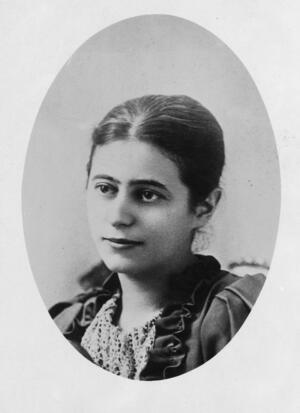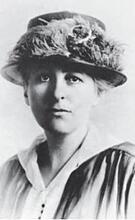Alice Goldmark Brandeis
A longtime activist for women’s equality and labor rights, Alice Brandeis also promoted progressive causes through the work of her husband, Supreme Court Justice Louis Brandeis. The Brandeises’ home in Washington, D.C., became a gathering place for liberal politicians, intellectuals, and journalists. Alice Brandeis did not shy away from controversial causes, including pacifism, efforts on behalf of anarchists Sacco and Vanzetti, radical presidential candidate Robert La Follette, and the Jewish activist Bergson Group.
Article
A champion of progressive causes, Alice Goldmark Brandeis was outspoken on behalf of women’s suffrage, industrial reform, organized labor, the legal rights of children, and the fledgling American Zionist movement.
Born in 1866 in Brooklyn to Austrian immigrants Dr. Joseph and Regina Goldmark, Alice and her three sisters and one brother were raised in an assimilated Jewish home. She was sent to a Unitarian Sunday School as a child and later maintained membership in the Unitarian Church while not formally renouncing her Jewish identity. She married attorney Louis D. Brandeis in 1891. The couple had two daughters, Susan (1893-1975), and Elizabeth (1896-1984).
The Brandeises settled in Boston, where Louis Brandeis’s legal activism soon gained him a reputation as “the people’s attorney” and Alice Brandeis assumed an increasing role advising him on strategies for promoting progressive causes.
After Louis was appointed to the U.S. Supreme Court in 1916, the Brandeises moved to Washington, D.C., where their home became a gathering place for liberal politicians, intellectuals, and journalists. Invitations to Alice’s carefully choreographed Sundays teas were extended to those whom the Brandeises believed would help “to carry on his crusade,” as one biographer put it.
Despite their prominence, the Brandeises maintained a notoriously modest life-style; the Zionist leader and Chicago judge Julian Mack once joked that meals at the Brandeis home were so sparing that guests knew they should eat before and after each visit.
Alice Brandeis was not one to shy away from controversial causes. A committed pacifist, she was an early member of the Massachusetts Women’s League for Peace and Freedom. She assisted in the campaign on behalf of anarchists Nicola Sacco and Bartolomeo Vanzetti, even permitting Sacco’s family to stay in the Brandeis home near Boston to make their prison visits easier. Alice also embraced the third-party presidential candidacy, in 1924, of Robert La Follette, a pacifist and advocate of government control of key industries). During World War II, she stirred some controversy by associating herself with the Bergson Group, a political action committee that lobbied for the rescue of European Jews and creation of a Jewish state in Palestine.
Alice Brandeis died on October 11, 1945.
AJYB, 48:485.
Mason, Alpheus Thomas. Brandeis: A Free Man’s Life. New York: The Viking Press, 1946.
Obituary. NYTimes, October 13, 1945, 15:3.
Strum, Philippa. Louis D. Brandeis: Justice for the People . Cambridge, MA: Harvard University Press, 1984.
Urofsky, Melvin I. Louis D. Brandeis and the Progressive Tradition. New York: Little, Brown, 1981.
Paper, Lewis J. Brandeis. New York: Prentice Hall, 1983.




